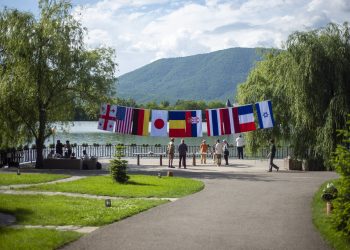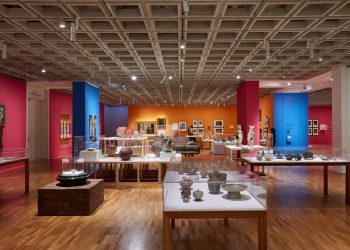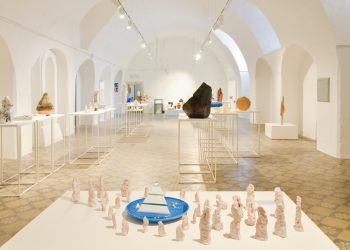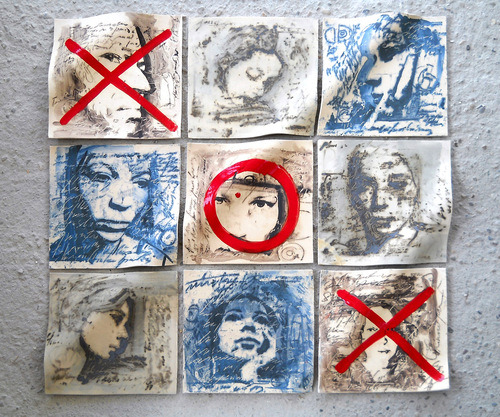
How did you discover the passion for ceramics?
By accident! When I was in high school, I studied painting, and I believed that nothing could rise to its value; that painting is part of my soul and the only way of expression for me as an artist. But this had changed when in university I have met ceramics, felt in loved and couldn’t separate since then. This is mainly due to my professor, Ernest Budeş, the person that showed us all the ways of expressing through this medium, using clay, stoneware, earthenware or porcelain, each with its specific techniques.
He taught us that ceramics is made with a lot of patience, dedication and most of all, love. He also educated us to love what we do because an object made with all these “ingredients” cannot be otherwise than good: it lives, vibrates, transmits.
Is ceramics for you an opportunity for introspection?
Art, in general, is an opportunity for introspection. Ceramics is a material that allows many possibilities of transposing artistic ideas, therefore, can be both two-dimensional (decorative tiles, painting, graphic, photography) and three-dimensional (sculpture, installation). In conclusion, clay has a wide range of artistic expressions that can help you translate almost any idea. Unlike other mediums, ceramics implies using all the primordial elements -earth, water, air, fire- to get the final result; this gives you a lot to think about. To give shape to earth you need water, to dry it you need air, but then, giving it to fire (and I say giving because from this point the fire detains most of the control and often is the best adviser and critic that reveals your mistakes and never forgives them) for objectification, fixing, vitrifying, finality.
Tell us more about your creative process. Is there a balance between concept and execution?
The important thing is to have the idea; the rest will follow naturally. When you master the ceramic techniques, you automatically consider the idea in connection with the execution possibilities; it is like the relation thought – word – grammar. You own the concept, the idea, the thought, and can transpose them using a grammatical structure. The same is with ceramics: you visualize the whole process to the ending, and you start to work, meanwhile transposing your thoughts.
It may happen to change the idea in the process – mainly because the difference of time between thought and action is longer than in other artistic media – for example in painting everything happens almost simultaneously (thought, gesture, action and result) but in ceramics, the execution time is slower and the mind begins to work – the reason changes can occur in the initial idea but also in technique. Usually, I try not to diverge too far from the main idea, but I have to be very careful because if I let myself flow in experiments, I can easily derail and fail to reach the destination, in other words to what I wanted to convey. Ceramics doesn’t give you many opportunities to step back in the process. Instead it forces you to take it again from beginning.
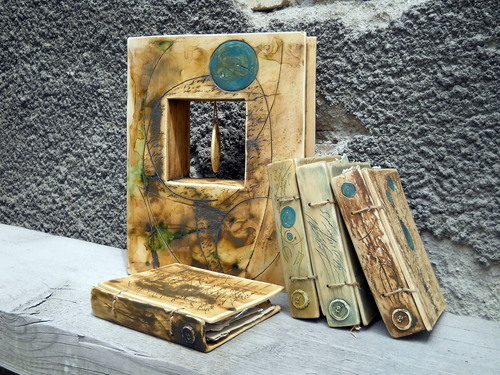
Aniela Ovadiuc, The book, 2011, Stoneware, Metalic oxides, 15 x 38 x 3 cm.
The book is a recurrent element in your creation. What are the origins of this passion?
During Master degree studies, I had as research the theme of the Library (Bookcase), concluding that it is the sum of human preoccupations. If Schopenhauer names the book “the paper memory of mankind”, my work “The Library” (Bookcase) wants to put in light the human – library relationship. The library has the meaning of a book depository where the books reflect the man himself. To understand this, I had to ask myself: What is a library? – A book depository; What is the book? – The memory of mankind in the shape of words, images, and signs; What are the words? – Language, signs, symbols, gesture. And still, what is the library? – Is purely a human product, which stores all its history and emphasizes the development path, all thoughts, feelings and human desires. All these are in the Universal Library, and man carries it with himself all the way. The library and the man go together, have a common, inseparable route, like a carried and projected shadow. So from now on, I remained faithful to this theme, because it is very complex and inexhaustible, because we are in constant motion and evolution, but especially because the book as an art object is as Daniela Frumuşeanu said – “an exhibition itself!”
As a Romanian artist, what is your opinion about the status of Romanian contemporary ceramics and the possibilities of affirmation in this country?
If by the 90’s, the Romanian contemporary ceramics were easily confused with traditional ceramics – because there were no magazines, catalogs and galleries in which to publish information, to promote and exhibit, through the years 2006 to 2009 a group of ceramic artists started to promote Romanian contemporary ceramics. After a so-called census we have found that, compared with the international ceramics, we have good artistic expertise, a well-defined value and various personalities, ideas, and good concepts – but all this could not be promoted due to financial shortcomings and organizational problems.
In 2009, at the initiative of ceramist Cristina Popescu Russu, as Aurelia Mocanu said, “an artist with a vast international experience and because of this with a big interest to maintain the group awareness of Romanian creators”, started a promoting process for Romanian contemporary ceramics. The first step was Mogoşoaia Palace Exhibition in Autumn 2009, where 33 artists from all over the country exhibited their works. Their ages were ranging from 25 to 75 years, it was a true panorama of Romanian ceramics.
This exhibition was completed with a trilingual catalog published by The “Brancovan Palaces” Cultural Center and took into consideration the display of Romanian ceramics in the French capital, in September 2010. The Romanian Cultural Institute in Paris hosted a selection of 14 ceramists in two conferences. All these events and artistic gatherings were mentioned at the conference and General Assembly of the International Academy of Ceramics in Geneva, the most exclusive forum for this field. Following these events we formed a group of eleven ceramists, and started the Galateea project. After two years of effort we managed to open the doors of Galateea Gallery in December 2011, being the only gallery for ceramics in Romania, included in the international circuit, which aims to promote Romanian contemporary ceramics.
Now, with the steps outlined above, we were able to shape the image of Romanian contemporary ceramics, which starts to be visible after almost 20 years of shade. We are at the beginning and the outcome of our efforts are slightly noticeable, but from now on is very important to maintain this attitude, to integrate and arise Romanian ceramics in an international context, and here I want to applaud the initiative of my colleagues from Cluj for launching an international ceramics magazine. I am very confident that we can accomplish the projects we set in mind, and happy to see so many reactions both to strengthen the Romanian ceramics but also to promote it and appreciate it.

Aniela Ovadiuc, Letter, 2012, Stoneware, Oxides, Glass, Paper, 15 x 38 x 3 cm.
Do you have a project you are currently working on? Where can we see your works in the next future?
Yes, I am involved in the Galateea project together with the group that had this initiative. Through Galateea we want to create a space for starters, for supporting the young ceramists but also a place where renowned artists from this field can showcase and be celebrated. This gallery is the perfect place for gatherings and debates on the perspectives of Romanian ceramics in the international context; a vivid place, a dialog generator between artists and the public.
Interview by Vasi Hirdo, published in Ceramics Now Magazine, Issue 2. Translation by Andra Baban.
View the list of interviews with ceramic artists.




